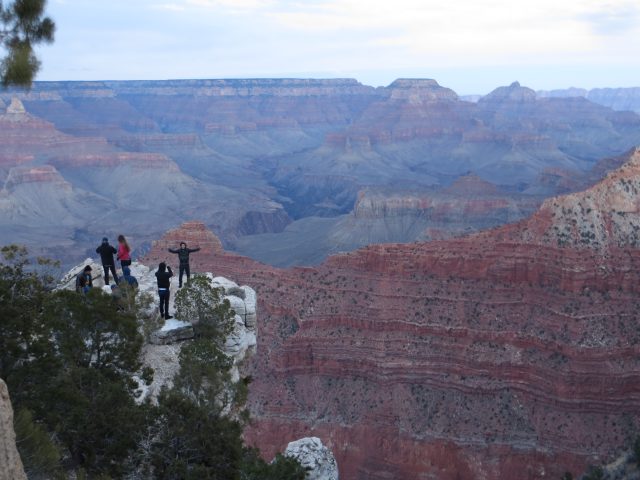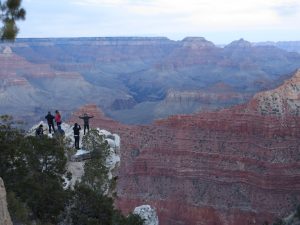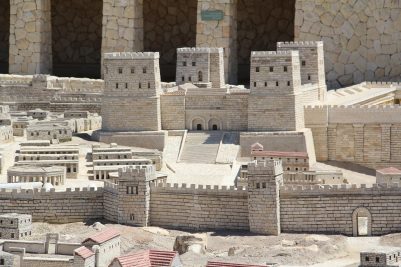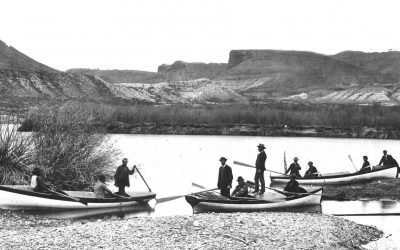The Second Wise Men

My wife Kristina and I have many interests in common, but two of our greatest passions, besides ministry, are traveling and photography. Every year for the past several years, we have made the trip to the GYC convention, and we often try to do some sightseeing along the way. GYC has been a time of spiritual encouragement for us, not to mention the time for some vacation, and a time to see relatives and friends.
One of the most memorable trips was our trip to Phoenix, Arizona, four years ago. We rented a large SUV and drove across the country with a whole group of young people. On our way, we stopped at the Grand Canyon.
(Listen to this message online here)

I don’t know about you. I know I’ve seen hundreds of photos of the Grand Canyon. I even watched an iMAX film about the Grand Canyon, which was pretty amazing itself, but nothing, and I repeat, NOTHING, could give you the same sense as standing there, on the edge of a cliff, and looking down a MILE straight down, past your toes and into the bottom of the canyon! No picture can give you the sense of awe that you get, watching the sunset across the canyon, and seeing the shadows play across the immense canyon walls. When I was growing up, my family and I visited the Grand Canyon, and we had the chance to hike a little ways down into the Canyon. I’ve always wanted to hike, or ride a mule, to the bottom. That’s still an item on my bucket-list. But I can tell you, the Grand Canyon something you have to see for yourself. It’s something you have to experience for yourself. I can tell you about it, but until you’ve been there, you haven’t seen the Grand Canyon.
You know, some things in life are like that. I believe that’s the reason why the highways are crowded around Christmas time. Sure, you could call your family on the phone at Christmas. You could Skype all your relatives, but it’s not the same as getting together in person. You can talk all day long, but you can’t feel a hug through Skype or FaceTime. You have to GO to Grandma’s house, to feel her arms around your neck, and to taste her delicious cooking!
The same could be said about going to GYC. I know a lot of folks are watching it online, or on 3ABN. And that’s great that we can do that. But there’s nothing like standing in a crowd of thousands of young people, singing together, or praying in small groups and hearing the reverent tone of thousands of others, all praying at the same time!
This, I believe, was the reason why, two thousand years ago, the wise men from the east were not content to simply read about the coming Messiah in the ancient prophecies. They were not content merely to see His star, but when they saw it, they had to GO. They had to see, for themselves, this king who was born in the land of Judea. And when they came, and when they saw, it says, they bowed down and worshiped Him. What they saw was far more than what they could have known from a distance.
But today I’m not talking about those wise men. The title of this message is simply the Second Wise Men. No, this is not a belated Christmas message—although I love the Christmas story. This is a different story, but I believe its message is the same message that we find at the heart of the Christmas story. The magi from the east came to find and worship the baby Jesus. The second wise men also came, seeking Jesus—not as a babe, but as a King. And just as the first wise men were shocked to find baby Jesus, with his parents, living as peasants, so the second would find that the Jesus they saw, was unlike anyone they had ever imagined Him to be.
It was not at Jesus birth, but rather, in the last week of His earthly life, that these wise men found Him. We find the story in John chapter 12. Jesus had recently raised Lazarus from the dead, and the word had spread about His mighty works. He had attended the eventful feast at Simon’s house, and his rapidly increasing popularity was enraging the Jewish leaders. He had entered Jerusalem in a triumphal procession, like never before, riding a young donkey, with shouts of Hosanna and the waving of palm branches. With authority He had cleansed the temple of the profane merchants, and had seated himself in its courts, teaching and healing.
Then, they came. But what they saw and heard was unlike any picture they had seen before!
John 12:20-22 “Now there were certain Greeks among those who came up to worship at the feast. Then they came to Philip, who was from Bethsaida of Galilee, and asked him, saying, ‘Sir, we wish to see Jesus.’ Philip came and told Andrew, and in turn Andrew and Philip told Jesus.”
As we look at this story together, I’d like to look at three simple questions:
How were these wise men led to Jesus?
 These men had come up to worship, with the Jews, at this Passover feast. They were Greeks—they weren’t Jews, but certainly they were believers in God, and worshipers of the true God. No doubt these were some of a great number of Gentiles who had come to believe in the true God, through the influence of the Jewish believers who, by now, were scattered among the nations of the world. These men, no doubt, had heard of Jesus. They had heard of His wonderful works—they had heard of His wonderful yet peculiar teachings. And now, they heard that He was in Jerusalem, teaching in the temple, and they desired nothing more, than to see and hear Him for themselves.
These men had come up to worship, with the Jews, at this Passover feast. They were Greeks—they weren’t Jews, but certainly they were believers in God, and worshipers of the true God. No doubt these were some of a great number of Gentiles who had come to believe in the true God, through the influence of the Jewish believers who, by now, were scattered among the nations of the world. These men, no doubt, had heard of Jesus. They had heard of His wonderful works—they had heard of His wonderful yet peculiar teachings. And now, they heard that He was in Jerusalem, teaching in the temple, and they desired nothing more, than to see and hear Him for themselves.
In a sense, you could say, these men were led to Jesus by his church—by the Jewish nation. Yes, the same nation whose leaders were now plotting to kill Jesus—these were the people that had inspired these Greeks with a knowledge of God, and had conveyed the message, perhaps unwittingly, of His ministry. I wonder if, in an age when we are so quick to criticize even the smallest errors in God’s church, if we can’t learn some lessons from this simple observation. God works through His people, even despite their mistakes and failures, to accomplish His purposes! Both the wise men from Babylon, and now these Greek visitors, are guided to Jesus through the Jewish leaders.
But one thing stood in the way, for these men to see Jesus. You see, they were not descendants of Abraham, and the Jews had set up a wall around the temple, with a sign that said, “Jews only beyond this point.” The Greeks could worship in the outer court, but they couldn’t come into the inner court where Jesus was teaching. So they found one of his disciples, Philip, and asked him to relay the message, “Sir, we wish to see Jesus.”
Now, Jesus own disciples get to play a role in this story. Philip meets the visitors, but it seems he’s a bit unsure how to proceed. Obviously the visitors can’t go into the Temple—but would Jesus come out to meet them? Unsure how to proceed, he goes and finds Andrew, and together they go and tell Jesus.
Philip is such an interesting character among Jesus disciples. He is not boisterous like Peter, but he is known in history as “the evangelist” or the bearer of good news. In John 1, upon first meeting Jesus, he runs to Nathanael and proclaims that he has found the Messiah. When Nathanael objects, “Can anything good come out of Nazarath,” Philip doesn’t argue. He simply responds, “Come and see.”
Now, when the men come asking, “We wish to see Jesus,” Philip is at hand to make sure that they, too, can meet the Messiah.
Perhaps there’s a lesson here, too. Jesus has given us, as His followers a great message. We are commissioned to preach and to teach—to tell others the Good News of the gospel. But the cry of the world is echoed in the words of the Greek visitors: “We would see Jesus.” And I believe the crux of our message should be centered in the words of Philip: “come and see.” The essence of every message should be leading others to the foot of the cross.
Who did these wise men see in Jesus?
These men had come, asking to see Jesus. Their request is granted. Jesus comes to them. They have heard about Jesus, but now they behold for themselves this man, whom many say IS the Messiah.
He is not dressed as a priest, or a king. The itinerant Rabbi wears the humble robe of a common peasant. But as they look in His eyes, they recognize the dignity of a King.
Isaiah 53:2-3
2 For He shall grow up before Him as a tender plant,
And as a root out of dry ground.
He has no form or comeliness;
And when we see Him,
There is no beauty that we should desire Him.
Jesus begins to speak:
John 12:23-24
But Jesus answered them, saying, “The hour has come that the Son of Man should be glorified. 24 Most assuredly, I say to you, unless a grain of wheat falls into the ground and dies, it remains alone; but if it dies, it produces much grain.
What is this that He is saying? Being glorified? Death? What could He mean?
Jesus continues:
(v 27-28) “Now My soul is troubled, and what shall I say? ‘Father, save Me from this hour’? But for this purpose I came to this hour. Father, glorify Your name.”
He begins with a prayer, like any of us would pray, in time of trouble. “Father, save Me from this hour.” But though he speaks the words, he does to pray this prayer. He asks it as a question: Shall I pray “Father, save Me?” When Peter prayed those words, as he slipped beneath the waves on stormy Galilee, Jesus instantly came to his rescue. How much more, Jesus knew, was His Heavenly Father ready to save Him from sorrow and agony. It was as though, for a moment, Jesus was already in the Garden of Gethsemane, and the visitors listen and watch, transfixed by this mysterious struggle taking place before them. “But” Jesus continues, “for this purpose I came to this hour.” He refuses to pray the prayer for deliverance, but instead, He utters four words: “Father, glorify Your name.”
Instantly, a voice thunders from heaven: “I have both glorified it and will glorify it again.” (v 28)
The disciples, the visitors, and the crowd stand transfixed, stunned by the thunderous voice. Clearly, Jesus is not an impostor. The voice of God Himself has just responded to the simple prayer of Jesus.
Jesus continues: (v 30-32) This voice did not come because of Me, but for your sake. Now is the judgment of this world; now the ruler of this world will be cast out. And I, if I am lifted up from the earth, will draw all peoples to Myself.
To be lifted up? Clearly, these men who’d come searching for Jesus, were hearing more than they expected to hear. Jesus had said the same words to Nicodemus in the midnight interview at the start of His ministry (John 3:14): “As Moses lifted up the serpent in the wilderness, even so must the Son of Man be lifted up.” How had Moses lifted up the serpent on a pole? On a pole—yes, on a cross!
These men had come, asking, “Sir, we wish to see Jesus.” Now the saw Him, not just as a man, but as the Son of Man, glorified by God. But before the week was over, they would see him hanging on a cross—not for himself, but for the healing of the world!
In the words of Isaiah 53:
Isaiah 53:3
He is despised and rejected by men,
A Man of sorrows and acquainted with grief.
And we hid, as it were, our faces from Him;
He was despised, and we did not esteem Him.
The second wise men were led to Jesus. The came asking “Sir, we wish to see Jesus.” And they saw in Him, I not only a man, but our Savior, and our Lord. Friends, I want to submit to you today, that you have not seen Jesus, until you have seen Him from the foot of the cross!
What were these wise men called to become through Jesus?
What are we called to become through Jesus?
Let’s back up to some verses we skipped a moment ago, to verses 24-26:
“Most assuredly, I say to you, unless a grain of wheat falls into the ground and dies, it remains alone; but if it dies, it produces much grain. 25 He who loves his life will lose it, and he who hates his life in this world will keep it for eternal life. If anyone serves Me, let him follow Me; and where I am, there My servant will be also. If anyone serves Me, him My Father will honor.”
A kernel of wheat, kept in the storehouse, will never be anything more than a kernel of wheat. In fact, wheat has been discovered in the ancient pyramids that has been kept for thousands of years. But it’s never multiplied. Not until you plant it in the ground will it grow and produce a harvest. It must die—the original kernel must be destroyed, before the new plant can grow. Not only was Jesus speaking of His own death, I believe he is speaking here about the experience of every one of His followers.
You know, sometimes I wish Jesus wouldn’t have been so hard on people, when they first met Him. I mean, He could have been so much more popular, if He hadn’t kept saying things like this. He told a promising young ruler, “Go sell everything you have, then come and follow me.” To another disciple, who simply asked, “Let me go bury my father,” He replied, “Follow Me, and let the dead bury their own dead.” And He says in Matthew 10:37-38 “He who loves father or mother more than Me is not worthy of Me. And he who loves son or daughter more than Me is not worthy of Me. And he who does not take his cross and follow after Me is not worthy of Me.” You know I wish sometimes that Jesus wasn’t so hard on people—I think Christianity would be a lot more popular, don’t you think, if you didn’t tell folks this kind of thing?
But that’s just the point. Jesus says, “It’s all or nothing.” You can’t be a Christian one day a week. You can’t serve Jesus part-time. You can’t say, “meh, I’ll see what it’s like.” It’s all or nothing. And in times like these, I might add, it’s now or never.
You see, trying to live the Christian life, without taking up the cross of Christ, is like trying to envision the Grand Canyon from a postcard, without actually going there.
 On May 24, 1869, John Wesley Powell set out from Green River, Wyoming. He, along with 9 other men and four boats, were on an expedition to explore the Colorado River. Three months later, he and five of his men would become the first (besides Native Americans) to run the Colorado River through the length of the Grand Canyon. Notice I said 5 men. One of his men abandoned the expedition at a re-supply stop in July, and went on to pursue a tamer sort of life. But three men abandoned the expedition just two days before they reached their intended destination—deciding it was better to find their way out of the canyon on foot, rather than brave the dangerous river any longer. They were never seen again. Historians believe they were likely killed by Indians along their journey.
On May 24, 1869, John Wesley Powell set out from Green River, Wyoming. He, along with 9 other men and four boats, were on an expedition to explore the Colorado River. Three months later, he and five of his men would become the first (besides Native Americans) to run the Colorado River through the length of the Grand Canyon. Notice I said 5 men. One of his men abandoned the expedition at a re-supply stop in July, and went on to pursue a tamer sort of life. But three men abandoned the expedition just two days before they reached their intended destination—deciding it was better to find their way out of the canyon on foot, rather than brave the dangerous river any longer. They were never seen again. Historians believe they were likely killed by Indians along their journey.
Explorers of every age of taken risks—in fact nothing great has ever been achieved in this world, without taking a risk. But the Christian life is more than a risk—it’s a commitment. When those men pushed off into the rapids, there was no turning back. And when we launch out into the Christian life, we must make a similar commitment—a commitment, as it were, to give up our very lives—ourselves, to be crucified with Christ, and to live as though we had already died.
Paul writes:
I have been crucified with Christ; it is no longer I who live, but Christ lives in me; and the life which I now live in the flesh I live by faith in the Son of God, who loved me and gave Himself for me. Galatians 2:20
Knowing this, that our old man was crucified with Him, that the body of sin might be done away with, that we should no longer be slaves of sin. Romans 6:6
Call
My friends, we’ve seen how, long ago, these honest men—I call them, the Second Wise Men, came looking for Jesus. “Sir, we wish to see Jesus” they said. And this is what they saw. They saw His disciples, Philip and Andrew, working together, not to tell them about Jesus, but to insure they they had an audience with Him in person. They saw Jesus—undoubtedly the Son of God, yet so committed to His Father that He was willing to go to the cross. And they heard His call—a call to commitment, to death, as it were—but also to a new life through Him.
My friends, I ask you today: Would you see Jesus? When others offer you an easier road, would you rather see Jesus? When it seems difficult, unpopular, and even awkward, would you see Jesus? When all the lights and glamour of this world are crying for your attention, would you rather see Jesus? When all you see before you is a cross, my friend, would you see Jesus? Would you go with Him to that cross? And when all is said and done—when the world is looking on—will they see Jesus in you?
Leave a Reply